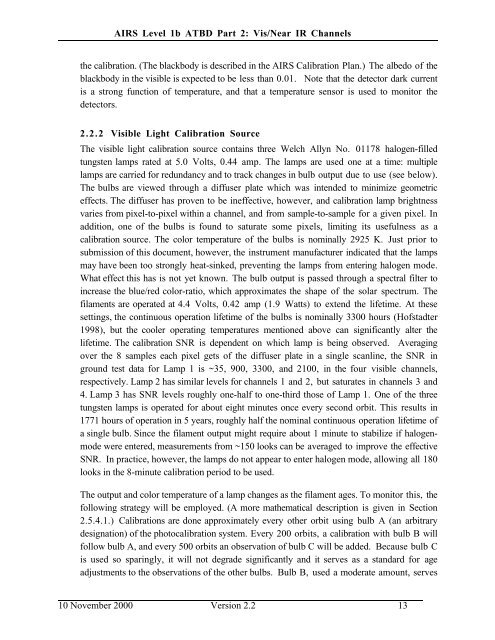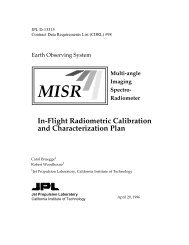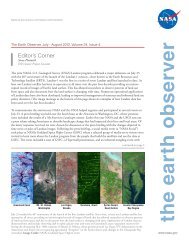AIRS Level 1B Visible/Near-Infrared Channels ATBD - NASA's Earth ...
AIRS Level 1B Visible/Near-Infrared Channels ATBD - NASA's Earth ...
AIRS Level 1B Visible/Near-Infrared Channels ATBD - NASA's Earth ...
Create successful ePaper yourself
Turn your PDF publications into a flip-book with our unique Google optimized e-Paper software.
<strong>AIRS</strong> <strong>Level</strong> 1b <strong>ATBD</strong> Part 2: Vis/<strong>Near</strong> IR <strong>Channels</strong><br />
the calibration. (The blackbody is described in the <strong>AIRS</strong> Calibration Plan.) The albedo of the<br />
blackbody in the visible is expected to be less than 0.01. Note that the detector dark current<br />
is a strong function of temperature, and that a temperature sensor is used to monitor the<br />
detectors.<br />
2.2.2 <strong>Visible</strong> Light Calibration Source<br />
The visible light calibration source contains three Welch Allyn No. 01178 halogen-filled<br />
tungsten lamps rated at 5.0 Volts, 0.44 amp. The lamps are used one at a time: multiple<br />
lamps are carried for redundancy and to track changes in bulb output due to use (see below).<br />
The bulbs are viewed through a diffuser plate which was intended to minimize geometric<br />
effects. The diffuser has proven to be ineffective, however, and calibration lamp brightness<br />
varies from pixel-to-pixel within a channel, and from sample-to-sample for a given pixel. In<br />
addition, one of the bulbs is found to saturate some pixels, limiting its usefulness as a<br />
calibration source. The color temperature of the bulbs is nominally 2925 K. Just prior to<br />
submission of this document, however, the instrument manufacturer indicated that the lamps<br />
may have been too strongly heat-sinked, preventing the lamps from entering halogen mode.<br />
What effect this has is not yet known. The bulb output is passed through a spectral filter to<br />
increase the blue/red color-ratio, which approximates the shape of the solar spectrum. The<br />
filaments are operated at 4.4 Volts, 0.42 amp (1.9 Watts) to extend the lifetime. At these<br />
settings, the continuous operation lifetime of the bulbs is nominally 3300 hours (Hofstadter<br />
1998), but the cooler operating temperatures mentioned above can significantly alter the<br />
lifetime. The calibration SNR is dependent on which lamp is being observed. Averaging<br />
over the 8 samples each pixel gets of the diffuser plate in a single scanline, the SNR in<br />
ground test data for Lamp 1 is ~35, 900, 3300, and 2100, in the four visible channels,<br />
respectively. Lamp 2 has similar levels for channels 1 and 2, but saturates in channels 3 and<br />
4. Lamp 3 has SNR levels roughly one-half to one-third those of Lamp 1. One of the three<br />
tungsten lamps is operated for about eight minutes once every second orbit. This results in<br />
1771 hours of operation in 5 years, roughly half the nominal continuous operation lifetime of<br />
a single bulb. Since the filament output might require about 1 minute to stabilize if halogenmode<br />
were entered, measurements from ~150 looks can be averaged to improve the effective<br />
SNR. In practice, however, the lamps do not appear to enter halogen mode, allowing all 180<br />
looks in the 8-minute calibration period to be used.<br />
The output and color temperature of a lamp changes as the filament ages. To monitor this, the<br />
following strategy will be employed. (A more mathematical description is given in Section<br />
2.5.4.1.) Calibrations are done approximately every other orbit using bulb A (an arbitrary<br />
designation) of the photocalibration system. Every 200 orbits, a calibration with bulb B will<br />
follow bulb A, and every 500 orbits an observation of bulb C will be added. Because bulb C<br />
is used so sparingly, it will not degrade significantly and it serves as a standard for age<br />
adjustments to the observations of the other bulbs. Bulb B, used a moderate amount, serves<br />
10 November 2000 Version 2.2 13







